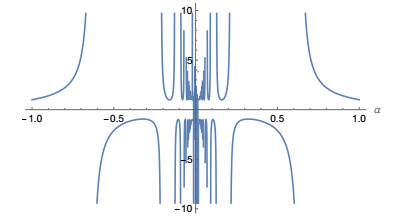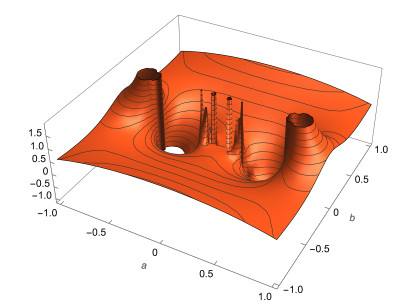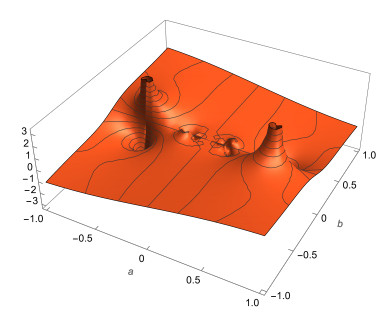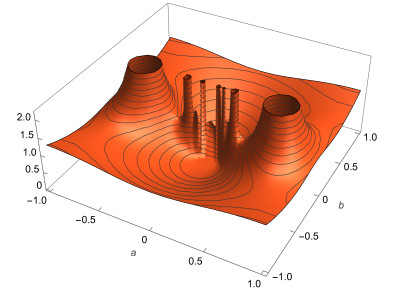1.
Introduction
Moreno et al. [1] published work involved in the evaluation of infinite products similar to the work previously published by Viète in 1593, which was based on geometric considerations [2,3]. A detailed compendium, with analysis and evaluations of infinite products of elementary functions in terms of trigonometric functions, is found in the book by Remmert [4]. Published work featuring sums and products of well-known functions such as Apostol-Bernoulli and Apostol-Euler numbers are detailed in [5,6,7].
This article develops and evaluates a number of Hurwitz-Lerch Zeta function-based finite and infinite series and products. The sum and product of this special function are calculated using the contour integral method given in [8]. The work in this article should encourage readers and their students to look for more proofs of these sums and proofs for related series and products, as well as serve as an example of one of several strategies for dealing with formulae of this nature. The derivation of interesting sums and products of finite and infinite series, as well as special instances for both types, are provided, along with plots in Figures 1–4.
The published work in [9] featured the contour integral method in [8] applied to the product of the cosine and cosecant functions and used to derive a finite sum involving the Hurwitz-Lerch Zeta function, where the first and third parameters involved powers of 2. In this current paper, we use the contour integral method in [8] and apply it to the difference method on page 131 in [10] for projection and finite series involving the Tangent function. This application yields both a finite and infinite sum of the Hurwitz-Lerch Zeta function in terms of the Hurwitz-Lerch Zeta function. A definite integral of an infinite product for Catalan's constant K is also derived.
Some special cases evaluated are in terms of Fibonacci and Lucas numbers which have numerous applications throughout algebraic coding theory, linear sequential circuits, quasicrystals, phyllotaxies, biomathematics, and computer science.
Our preliminaries start with a contour integral method and a few formulae. Let a, k, m, α, β and w be general complex numbers and j∈[0,∞), the contour integral forms [8] of the Durell-like sum in [10] are given by
and
The derivations follow the method used by us in [8]. This method involves using a form of the generalized Cauchy's integral formula given by
where y,w∈C and C is in general an open contour in the complex plane where the bilinear concomitant [8] has the same value at the end points of the contour. This method involves using a form of Eq (1.3) then multiplies both sides by a function, then takes the sum of both sides. This yields a sum in terms of a contour integral. Then, multiply both sides of Eq (1.3) by another function and take the infinite sum of both sides such that the contour integral of both equations are the same.
2.
The Hurwitz-Lerch Zeta function
Use Eq (1.11.3) in [11] where Φ(z,s,v) is the Hurwitz-Lerch Zeta function which is a generalization of the Hurwitz Zeta ζ(s,v) and Polylogarithm functions Lin(z). The Lerch function has a series representation given by
where |z|<1,v≠0,−1,−2,−3,.., and is continued analytically by its integral representation given by
where Re(v)>0, and either |z|≤1,z≠1,Re(s)>0, or z=1,Re(s)>1.
3.
Derivation of the finite sums of the contour integral representation
In this section, the Cauchy integral formula is use and the stated contour integral method to derive the finite sum of the Hurwitz-Lerch Zeta functions in terms of its contour integral representation (1.1).
3.1. Left-hand side first contour integral
Using a generalization of Cauchy's integral formula (1.3), first replace y→log(a)+2iα1−j+2iyα1−j then multiply both sides by −2i(−1)yβ1−je2im(y+1)α1−j and take the infinite sums over y∈[0,∞) and j∈[0,n] and simplify in terms of the Hurwitz-Lerch Zeta function to get
from Eq (1.232.1) in [12] where Re(m+w)>0 and Im(m+w)>0 in order for the sums to converge. Apply Tonelli's theorem for multiple sums, see page 177 in [13] as the summands are of bounded measure over the space C×[0,n]×[0,∞).
3.1.1. Derivation of the additional contour
Using a generalization of Cauchy's integral formula (1.3), first replace y→log(a) then multiply both sides by −iβ1−j and simplify to get
3.2. Left-hand side second contour integral
Using a generalization of Cauchy's integral formula (1.3), first replace y→log(a)+2iα−j+2iyα−j then multiply both sides by 2iβ−jei(2m(y+1)α−j+πy) and take the infinite sums over y∈[0,∞) and j∈[0,n] and simplify in terms of the Hurwitz-Lerch Zeta function to get
from Eq (1.232.1) in [12] where Re(m+w)>0 and Im(m+w)>0 in order for the sums to converge. Apply Tonelli's theorem for multiple sums, see page 177 in [13] as the summands are of bounded measure over the space C×[0,n]×[0,∞).
3.2.1. Derivation of the additional contour
Using a generalization of Cauchy's integral formula (1.3), first replace y→log(a) then multiply both sides by iβ−j and simplify to get
3.3. Right-hand side first contour integral
Using a generalization of Cauchy's integral formula (1.3), first replace y→2iα+log(a)+2iαy then multiply both sides by −2iβei(2αm(y+1)+πy) and take the infinite sums over y∈[0,∞) and simplify in terms of the Hurwitz-Lerch Zeta function to get
from Eq (1.232.1) in [12] where Re(m+w)>0 and Im(m+w)>0 in order for the sum to converge. Apply Fubini's theorem for integrals and sums, see page 178 in [13] as the summand is of bounded measure over the space C×[0,∞).
3.3.1. Derivation of the additional contour
Using a generalization of Cauchy's integral formula (1.3), first replace y→log(a) then multiply both sides by −iβ and simplify to get
3.4. Right-hand side second contour integral
Using a generalization of Cauchy's integral formula (1.3), first replace y→log(a)+2iα−n+2iyα−n then multiply both sides by −2iβ−nei(2m(y+1)α−n+πy) and take the infinite sums over y∈[0,∞) and simplify in terms of the Hurwitz-Lerch Zeta function to get
from Eq (1.232.1) in [12] where Re(m+w)>0 and Im(m+w)>0 in order for the sum to converge. Apply Fubini's theorem for integrals and sums, see page 178 in [13] as the summand is of bounded measure over the space C×[0,∞).
3.4.1. Derivation of the additional contour
Using a generalization of Cauchy's integral formula (1.3), first replace y→log(a) and multiply both sides by −iβ−n then simplify to get
4.
Derivation of the infinite sums of the contour integral representation
In this section, the Cauchy integral formula is used and the stated contour integral method to derive the infinite sum of the Hurwitz-Lerch Zeta functions in terms of its contour integral representation (1.2).
4.1. Left-hand side first contour integral
Using a generalization of Cauchy's integral formula (1.3), first replace y→log(a)+2iα1−j+2iyα1−j then multiply both sides by −2i(−1)yβ1−je2im(y+1)α1−j and take the infinite sums over y∈[0,∞) and j∈[0,∞) and simplify in terms of the Hurwitz-Lerch Zeta function to get
from Eq (1.232.1) in [12] where Re(m+w)>0 and Im(m+w)>0 in order for the sums to converge. Apply Tonelli's theorem for multiple sums, see page 177 in [13] as the summands are of bounded measure over the space C×[0,∞)×[0,∞).
4.1.1. Derivation of the additional contour
Using a generalization of Cauchy's integral formula (1.3), first replace y→log(a) then multiply both sides by −iβ1−j and simplify to get
4.2. Left-hand side second contour integral
Using a generalization of Cauchy's integral formula (1.3), first replace y→log(a)+2iα−j+2iyα−j then multiply both sides by 2iβ−jei(2m(y+1)α−j+πy) and take the infinite sums over y∈[0,∞) and j∈[0,∞) and simplify in terms of the Hurwitz-Lerch Zeta function to get
from Eq (1.232.1) in [12] where Re(m+w)>0 and Im(m+w)>0 in order for the sums to converge. Apply Tonelli's theorem for multiple sums, see page 177 in [13] as the summands are of bounded measure over the space C×[0,∞)×[0,∞).
4.2.1. Derivation of the additional contour
Using a generalization of Cauchy's integral formula (1.3), first replace y→log(a) then multiply both sides by iβ−j and simplify to get
4.3. Right-hand side first contour integral
Using a generalization of Cauchy's integral formula (1.3), first replace y→2iα+log(a)+2iαy then multiply both sides by −2iβei(2αm(y+1)+πy) and take the infinite sums over y∈[0,∞) and simplify in terms of the Hurwitz-Lerch Zeta function to get
from Eq (1.232.1) in [12] where Re(m+w)>0 and Im(m+w)>0 in order for the sum to converge. Apply Fubini's theorem for integrals and sums, see page 178 in [13] as the summand is of bounded measure over the space C×[0,∞). Using a generalization of Cauchy's integral formula (1.3), first replace y→log(a) then multiply both sides by −iβ and simplify to get
5.
Finite and infinite sums of the Hurwitz-Lerch Zeta functions in terms of the Hurwitz-Lerch Zeta functions
In this section, the main theorems are developed and used in this work to evaluate special cases and produce double sum formulae and a table of infinite products of trigonometric functions. Possible application of the infinite form given by Eq (5.2) is in the evaluation of the analytic solution of the imaginary part of Eq (34) in [14]. Possible application of the finite form given by Eq (5.1) is in the evaluation of the Eq (2) in [15].
Theorem 5.1. For all k,a,α,β,m∈C,n∈Z+,
Proof. Since the addition of the right-hand sides of Eqs (3.1)–(3.4), is equivalent to the addition of the right-hand sides of Eqs (3.5)–(3.8) one may equate the left-hand sides and apply Eq (1.1) and simplify the Gamma function to yield the stated result.
Theorem 5.2. For all k,a,α,β,m∈C,
Proof. Since the addition of the right-hand sides of Eqs (4.1)–(4.4), is equivalent to the addition of the right-hand sides of Eqs (4.5) and (4.6), may equate the left-hand sides and apply Eq (1.2) and simplify the Gamma function to yield the stated result.
6.
The degenerate cases
Example 6.1.
Proof. Use Eq (5.1) and set k=0 and simplify using entry (2) in table of Section (64:12) in [16].
Proof. Use Eq (5.2) and set k=0 and simplify using entry (2) in table of Section (64:12) in [16].
7.
Special cases
In this section, Eqs (5.1) and (5.2) will be evaluated to derive infinite and finite product representations for the quotient of the cosine function raised to a complex power. The comparison to the derived results with those published by Moreno et al. [1] as in some cases more generalized formulae were achieved. We also provide plots of special cases in Figures 1–4.
Example 7.1.
Proof. Use Eq (5.1) and form a second equation by replacing m by r and take their difference and set k=−1,a=1 and apply the method in section (8) in [17] then simplify using entry (3) in table of Section (64:12) in [16]. The final form is derived by multiplying itself after replacing m→−m,r→−r and simplifying.
Example 7.2. Lucas numbers and golden ratio over complex numbers where Re(α)>Re(β)>1.
Proof. Use Eq (7.1) and set m→π10α,r→πα and simplify. The Lucas numbers are listed in equation (3.1.2.6) in [18].
Example 7.3.
Proof. Use Eq (7.1) and set m→π5α,r→πα and simplify. The Lucas numbers are listed in Eq (3.1.2.6) in [18].
Example 7.4. Infinite product in terms of quotient cosine functions with reciprocal angles and symmetric plots.
Proof. Use Eq (5.2) and form a second equation by replacing m by r and take their difference and set k=−1,a=1 and apply the method in section (8) in [17] then simplify using entry (3) in table of Section (64:12) in [16]. The final form is derived by multiplying itself after replacing m→−m,r→−r and simplifying.
Example 7.5. Product representation for the reciprocal of the Pythagoras constant given by 1√2 given in [19].
Proof. Use Eq (7.4) and set m→π3,r→π4,α→4,β→3 and simplify.
Example 7.6. Product representation for the constant √5.
Proof. Use Eq (7.4) and set m→π5,r→π6,α→2,β→3 and simplify.
Example 7.7. Product representation for the golden ratio where the constant ϕ=12(1+√5) is given by Eq (3.1.2.3) in [18].
Proof. Use Eq (7.4) and set m→π10,r→π3,β→1,α→2 and simplify.
Example 7.8. Product representation for the golden ration raised to a complex power.
Proof. Use Eq (7.4) and set m→π5α,r→2πα and then α→2α and simplify.
Example 7.9. Product representation for the golden ration raised to a complex power.
Proof. Use Eq (7.4) and set m→2π5α,r→2πα and then α→2α and simplify.
Example 7.10. Product representation for the quotient of radicals √2 and √5.
Proof. Use Eq (7.4) and set m→π30,r→π160,α→4,β→1 and simplify.
Example 7.11. Product representation for the quotient of cosine functions.
Proof. Use Eq (7.4) and set α→2β,m→m2β,r→r2β and simplify.
Example 7.12. A product representation for the cosine function.
Proof. Use Eq (7.4) and set r→0,α→2,m→z2,β→1 and simplify. This is an alternate representation to the Euler product representation in Chapter 1. Section (3.1) in [4].
Example 7.13. A product representation for the secant function.
Proof. Use Eq (7.4) and set m→0,α→2,r→z2,β→1 and simplify.
Example 7.14. Product representation for the square root of the quotient of cosine functions.
Proof. Use Eq (7.4) and set α→4β,m→m4β,r→r4β and simplify.
Example 7.15. Alternate product representation for Eq (13) in [1].
Proof. Use Eq (7.12) and set z→−cos−1(2√3) and simplify.
Example 7.16. Generalized product representation for Theorem 4 in [1].
Proof. Use Eq (7.4) and set α→2β,m→m2β,r→r2β and simplify followed by setting m→x,r→3π10 and simplify.
Example 7.17. Generalized product representation for Theorem 5 in [1].
Proof. Use Eq (7.11) and set m→cos−1(√1−z24),r→3π10 and simplify.
Example 7.18. Definite integral of an infinite product in terms of Catalan's constant K.
Proof. Use Eq (7.11) and set m→0,r→it then multiply both sides by t and take the infinite integral over t∈[0,∞) and simplify using Eq (3.521.2) in [12].
8.
Conclusions
In this paper, we have presented a method for deriving new finite and infinite products involving the cosine function along with some interesting special cases using contour integration. We hope that our approach will be helpful for those interested readers who want to obtain their own product formulae. The results presented were numerically verified for real, imaginary and complex values of the parameters in the products using Mathematica by Wolfram.
Conflict of interest
The author declares no conflict of interest.










 DownLoad:
DownLoad:






